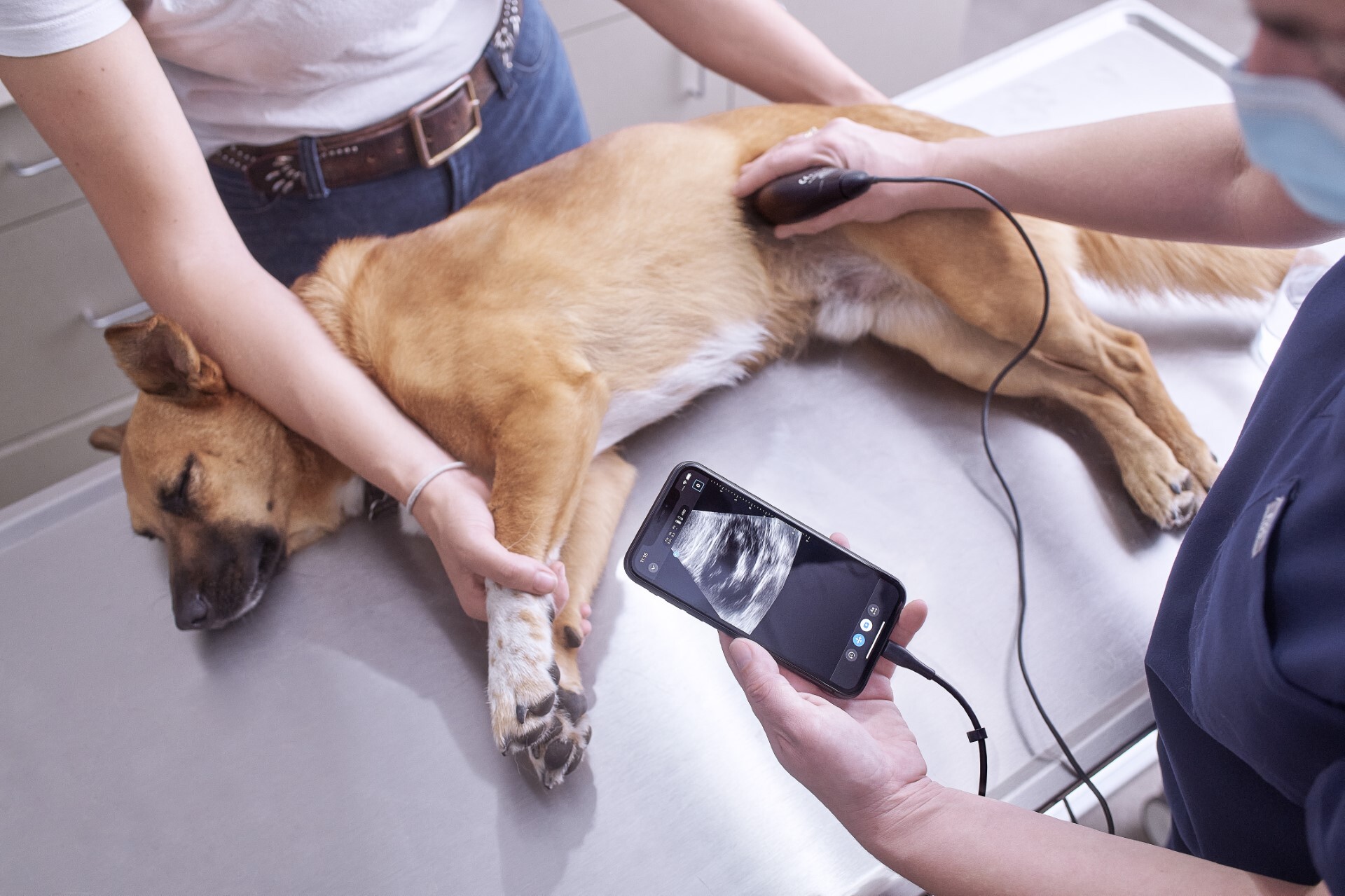By Marc Bordelon, DVM, MBA
The contemporary use of ultrasound in veterinary medicine has evolved from its inception solely as a referral tool for use by specialty veterinarians to a practical and useful diagnostic tool in general practice and emergency medicine. Veterinarians and staff should be prepared to explain the purpose and procedures involved in point of care ultrasound (POCUS) as well as possible pros and cons to pet parents. Despite being a non-invasive procedure that is virtually painless and quick to perform, there may be concern around logistics, outcomes, and cost. The vet team should be prepared with information to make ultrasound examinations comfortable and pleasant for patients and clients alike.
Client conversations will include questions regarding how ultrasonography and POCUS is used in veterinary practice. Consider the indication for the ultrasound recommendation: is it routine, preventive, diagnostic, or emergency? Routine and preventive medicine ultrasounds are becoming more common. Practices create bundle packages with their wellness exams that are customizable depending on the pet’s age and physical exam findings. It is feasible to say that by looking early and often, a baseline for normal will be established for each patient, and evolution to disease states may be diagnosed sooner, rather than waiting for clinical changes to prompt an ultrasound investigation. Early diagnosis has an immediate impact on patient health and well-being and client experience. Providing routine ultrasounds at an affordable price is simply smart medicine.
Today, routine ultrasonography doesn’t require expensive equipment purchases. Affordable, hand-held ultrasound tools, like the Butterfly iQ+ Vet, are extremely durable, easily connected to a cell phone or tablet, and carried in the clinician’s or technician’s pocket. This model dramatically increases access to ultrasound for every veterinary hospital. Additionally, handheld ultrasound can be utilized in any exam room, with the educated client actively witnessing and perhaps even participating in the process, never having to leave the side of their fur baby.
POCUS examinations are indicated in both routine and emergency care. POCUS is performed using protocols to scan known areas of interest in the thoracic cavity, including heart and lungs, and four quadrants of the abdominal cavity. Abnormalities such as free fluid or air can be quickly identified and may help determine patient stability in the emergency setting, often in 10 minutes or less. This allows the veterinary team to determine the appropriate next steps and monitor patient progress. Questions to consider during the emergency POCUS exam may include the following:
- Do these findings explain the pet’s clinical disease state?
- What are the next steps in this treatment plan?
- Is there an abnormality that requires further exploration?
- Should this patient be referred to a specialist?
Utilizing POCUS examinations in practice is a valuable and effective diagnostic tool. Scanning sick patients on the first presentation offers an important baseline for each case. Embedding the ultrasound cost into the exam and making it affordable ensures better compliance. This approach helps forge a strong veterinary-client-patient relationship and may add the satisfaction of an early and accurate diagnosis for the veterinarian.
Multiple studies have proven that early implementation of procedures like POCUS can lead to better case outcomes, quicker workups, increased client satisfaction, and the ability to get a diagnosis early on in the disease state.
Getting Patients Comfortable
Now let’s look at patient protocols. Depending on the type of ultrasound exam needed and the reason for presentation (routine, sick, or emergency) there are several ways to make the ultrasound procedure more comfortable for both patients and clients.
Diagnostic imaging presents a unique challenge because it is important for the animal to remain quiet, comfortable, and still. The use of a sedative, and in some cases anesthesia, will be necessary to collect the desired images for some patients. Use of the following practices can decrease stress for patients and help them remain calm and still during an ultrasound examination in the Fear Free environment:
- Introduction and positive conditioning to ultrasound probes and POCUS for kittens and puppies
- Non-slip comfortable surface
- Warmed ultrasound gel
- Calming scents such as lavender and canine or feline pheromones
- Relaxing background music or white noise.
- Low traffic area with limited distractions
- Minimal noise pollution (other animals, people talking, equipment alarms, intercoms)
Positioning is also important in ultrasound examinations. Patients should feel safe and secure during preparation and procedure. Evaluation of fear, anxiety and stress (FAS) should be monitored throughout. Here are several ways to position a pet while helping them to remain comfortable, while first considering physical limitations.
- Determine if the procedure can be performed with the patient in a non-traditional position such as standing or laying comfortably on their side.
- Determine if the pet can get into position on cue; for instance, rolling onto their side.
- If the pet does not know such a cue, use a lure to help guide the pet into position.
- If luring doesn’t work, the pet can be physically guided into position, but this is the most stressful option. It is imperative that the pet feels supported and stable when being guided into position.
When the above positioning options aren’t possible, Dr. Caroline Conn of Sweetwater Veterinary Clinic in Santa Clarita, California, an Elite Fear Free Certified Professional, routinely uses the following techniques in her ultrasound exams:
- Sedation (after approval from owner, mainly for emergencies and diagnostic abdominal scans)
- Performs ultrasound in client presence when possible (increased value for client)
- *Cooperative Care technique: This technique takes time for both the veterinarian to teach and client to practice. Absolute buy-in is a must before using this for pre-scheduled appointments. The Cooperative Care technique utilizes the client teaching their pet how to get in lateral recumbency and/or dorsal recumbency on their own at home beforehand, to simulate the positioning of an ultrasound exam.
- When the pet is properly positioned, the owner places cool water or non-scented hand sanitizer on the area to be ultrasounded to stand in for ultrasound gel, and uses an object like a remote to simulate use of an ultrasound wand. (Advise clients to wipe off hand gel after use as it can be toxic if ingested.)
- Patients remain in position for a few minutes to start, gradually building up to 10 minutes. During this time, the owner gives treats to their pet, which act as a distraction and reinforcement for remaining in position to create a positive experience.
- However, it is done, safe handling is a must for both pets and the veterinary team. Utilizing the core Fear Free concepts, such as Gentle Control, Touch Gradient, Considerate Approach, FAS evaluation, and communication, ensure the physical and emotional wellbeing of all involved.
Pain and Fear Reduction
In an emergency situation, medications for pain and fear are often needed. Analgesia and anxiolytics not only help the pet physiologically and emotionally, they also help to reduce the client’s stress when they see that their pet is comfortable.
Reducing pain and fear also has an emotional and physiological advantage because the pet is now more approachable and feels safe being examined or undergoing blood draws or other emergency procedures. This also translates to a safer environment for staff.
Keeping Clients Comfortable
Keeping the client comfortable and informed is almost as important as keeping the pet comfortable. A comfortable patient makes for a happier, satisfied client. In addition to the benefits of hand-held ultrasound devices, here are some additional ways to increase client comfort and decrease their stress:
- Have a veterinary technician/nurse or veterinarian greet the client at the door. This lets them know right away that their pet will not have to wait for treatment.
- Have their animal’s medical records accessible. If possible, in an emergency situation, speak to their regular veterinarian for background information on the pet.
- Take time to connect by greeting the client and the pet, and sharing what information you have about the pet’s condition.
- Remember that honesty is the best policy. Be upfront with clients about possible wait times, cost, and the severity of their pet’s emergency.
- Reduce pain, fear, anxiety, and stress ASAP. Get approval from the client to administer medications as soon as you have enough information on the case and can determine which medications are appropriate.
- Over communicate. If you must take the pet away from the owner for treatment, provide updates every 10 minutes on how the pet is doing. As the case progresses, you can customize the frequency of updates depending on how critical the pet’s situation is.
Summary of Fear Free POCUS
Hand held ultrasound has made the use of POCUS more feasible in all areas of veterinary medicine. As its use and acceptance grow, Fear Free techniques will be incorporated into these procedures. Clients should be educated on the benefits offered by POCUS in routine, sick and emergent cases. Patient comfort must be considered and addressed in all cases (FAS) as the patient is positioned and the scan is performed. Client participation is optimal if it is safe and quiets the pet. If the pet parent cannot be with their fur baby, frequent communication is imperative.
Consider the following guidelines for POCUS procedures, in addition to established Fear Free protocols:
- Early introduction and positive conditioning to ultrasound probes for kittens and puppies
- Non-slip comfortable surfaces are safest and create less anxiety
- Warmed ultrasound gel
- Use calming scents such as lavender, or canine or feline pheromones
- Relaxing background music or white noise
- Utilize low traffic area with limited distractions
- Minimal noise pollution (other animals, people talking, equipment alarms, intercoms)
This article was reviewed/edited by board-certified veterinary behaviorist Dr. Kenneth Martin and/or veterinary technician specialist in behavior Debbie Martin, LVT.
Marc Bordelon, DVM, MBA, is veterinary clinical senior manager for Butterfly Network. Dr. Bordelon regularly lectures at several veterinary colleges and participates in wet labs and with other professionals in conference settings. Dr. Bordelon formerly owned multiple veterinary practices including a 24/7 hospital and specialty practice, and has routinely performed over 2,000 ultrasounds a year. To contact Dr. Bordelon, you can email him at MarcBordelon@butterflynetwork.com. To contact the Butterfly Veterinary Team please email vetsupport@butterflynetwork.com
Want to learn more about Fear Free? Sign up for our newsletter to stay in the loop on upcoming events, specials, courses, and more by clicking here.
Brought to you by our friends at Butterfly.







